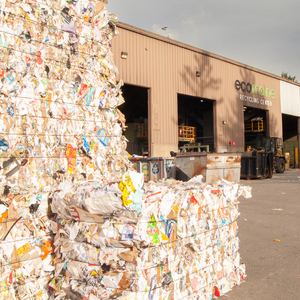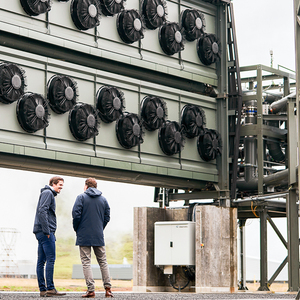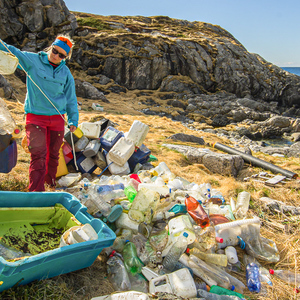
This post originally appeared at Yale Environment 360.
Coca-Cola calls it the PlantBottle—a new kind of recyclable plastic container, 30% of which is made from sugar cane and other plants, with the remaining 70% made from traditional oil-based plastic. The company says that PlantBottle packaging now accounts for nearly a third of its North American bottle volume and 7% percent globally.
Does the PlantBottle mean the giant soft drink company has cracked one of the world’s most serious environmental problems, the choking of the world with oil-based plastics that never completely break down and disappear? Hardly. Though companies like Coca-Cola and Pepsi are under public pressure to solve the problem of plastic pollution, they have so far been unable to find a material or method as cheap and effective as single-use plastic.
Bioplastics, which make up part of Coke’s PlantBottle, have been touted as an important solution to the world’s plastic pollution problem. But despite a growing push in recent years to come up with an organic plastic that satisfies product needs and, after use, becomes part of nature again, making bioplastics that are both cheap and effective has posed a major challenge.
“The concept that we could use it, throw it away, and it doesn’t matter where you throw it, and it’s going to safely disappear, that does not exist,” said Ramani Narayan, a professor at the School of Packaging at Michigan State University. “Nobody could engineer something like that, not even nature.”
Instead, many experts believe the solution to plastic waste mainly lies not in developing better bioplastics, but in overhauling the world’s economy to recycle far-greater quantities of plastic than currently are being reused. A just-released two-year study called Breaking the Plastic Wave by Pew Charitable Trusts and SYSTEMIQ, found that despite the efforts of industry, governments, and NGOs, the plastic problem is getting much worse.
Indeed, a recent study in the journal Science, authored by the researchers associated with the Pew report, estimated that some 11 million metric tons of plastic now find their way into the oceans each year—3 million more than previous estimates. The study said that if the world continues on its current course of skyrocketing plastic consumption, the amount of plastic waste being produced will triple by 2040.
The only solution to this burgeoning problem, the Pew report concludes, is a massive $600 billion overhaul of the world’s plastic system that reuses and recycles plastic in a circular economy, along with other, smaller-scale changes, including bioplastics. If its recommendations are adopted, the Pew report says, plastic waste could be reduced by 80% over the next two decades.
Recycling and packaging re-examined
Among the remedies proposed in the report are the elimination of plastic packaging wherever possible, substituted with paper or compostable material; designing products for effective recycling; increasing mechanical recycling; scaling up collection and recycling efforts in moderate- and low-income countries, where the vast majority of ocean plastic originates; and an end to exports of waste plastic, which would force countries where the waste is generated to come up with solutions to the plastics problem.
Marian Chertow, an expert in industrial ecology at the Yale School of the Environment, says that a key step is taking the onus off governments for recycling and instead requiring companies that use the packaging to play a lead role in its recycling and reuse.
“It’s called extended producer responsibility—product take-back,” says Chertow. Governments “should say, ‘We can’t recycle all of this stuff. We can’t pay for all the costs of recycling. We have to work with you, the producer.’”
The notion of industry bearing the financial burden for recycling the materials it produces is starting to gain some traction, with companies such as Nestle Waters vowing to support moves to implement extended producer responsibility in the beverage industry.
From the shores of the Arctic Ocean, to the beaches of the Mediterranean, to the rivers of India, plastic is accumulating in staggering quantities, especially in marine environments. The Great Pacific Garbage Patch has now grown so large that it is spread across an area four times the size of California, according to a study in the journal Scientific Reports. And this plastic, which eventually breaks down into nanoscale particles and is consumed by organisms from algae to whales, will never go away.
The myth about bioplastics
So why have bioplastics, touted as an important solution to the plastic problem, fallen far short of their promise?
Single-use plastic packaging made from oil—technically polyethylene terephthalate, or PET—is the kind most drinks and food are sold in. It is, in many ways, the perfect packaging—strong, light, versatile, clear, and inexpensive. It protects products extremely well, keeps them fresh, and can even stand up to the acid and pressurization of soft drinks without breaking down or becoming permeable over months or years.
Bioplastic needs to replicate these functions, and it does for some products. The two most commonly used bioplastics are PHA, short for polyhydroxyalkanoate, generally made from sugars that are grown from algae, and PLA, for polylactic acid, which is made from the sugar found in crops like corn and sugarcane. PLA is a tenth the cost of PHA and so is more widely used for disposable cutlery and a variety of packaging. PHA is used as a coating for the inside of paper cups and medical applications.
Neither of these bioplastics is widely used, however, because they simply don’t compare to the strength and other properties of traditional plastic, and they cost substantially more. The global plastic market is worth $1.2 trillion, and bioplastics have a market share of $9 billion.
While both of the bioplastics now in use can be broken down by microorganisms and become part of the natural world again in a short period of time, this only happens if the plastic is collected and composted in carefully controlled, high-temperature industrial composting facilities—and there aren’t many of those, especially in developing countries where the problem of plastic pollution is most severe.
If bioplastics end up in landfills, as many do, without enough oxygen to break them down, they can last for centuries and release methane, a potent greenhouse gas. If thrown into the environment, they pose threats similar to PET plastic.
“They are basically the same as plastic and don’t decompose in the way most people think they do,” said Rebecca Burgess, CEO of City to Sea, a UK environmental nonprofit that was formed to reduce plastic in the oceans. “They often end up as rubbish littering our streets and oceans and killing marine life. Bioplastics are a ‘false solution’ as they are single use and there are limited options to compost them… Reducing the amount of single-use packaging we use is the only solution.”
The drawbacks of bioplastics to date haven’t stopped marketers like Coca-Cola from implying the plastic pollution problem is being solved. They use the popular, if vague, terms “plant-based” or “bio-based” or “compostable,” for example. “Marketing is highly abusive in this area,” said Taylor Weiss, an assistant professor at Arizona State University who researches algae-based bioplastics.
Even a 100-percent plant-based bottle is not the solution it might seem. Not only can bioplastics find their way into the environment and take many years to break down, but because they are made from plants, they come with the environmental problems that large-scale agriculture causes. The sugars used to make bioplastic often come from transgenic crops sprayed with herbicides and pesticides, and these crops take land out of production that is needed to feed a growing global population. This mirrors the problems found in biofuels, which were similarly seen as an environmental solution. Experts say that using bioplastic and biofuels will greatly increase the land needed for agriculture.
And because PLA’s are generally mechanically recycled—which means they are cleaned, shredded, melted down, and made into pellets to be used again—they can contaminate the waste stream of petroleum-based plastics that are chemically recycled.
On the other hand, PHAs can be made from sugars grown in algae and so there is no impact on food production. But using algae to produce bioplastic ingredients is expensive and it could take years before PHA plastics could be scaled up to a level that substantially decreases the cost.
‘There isn’t a silver bullet’
Experts say that the challenges of introducing bioplastics on a massive scale show how hard it will be to replace the billions of plastic bottles polluting the planet.
“There isn’t a silver bullet,” said Simon Reddy, who directs Pew’s ocean plastic program and was an author of the recent report. Instead, a variety of new approaches are needed to overhaul the current economy. “It’s about designing products for recycling,” he said. “Currently we don’t do that. The information on the label about plastics is vague and unintelligible. The recyclability should be first and foremost.”
In Europe about 42% of plastic packaging was recycled in 2017, while in the U.S. just 8.4% of plastic is recycled.
Some small recycled plastic successes are taking place. Evian, the spring water bottler, recently launched a bottle made from 100% recycled PET. The company says its goal is to become what is known as “fully circular”—to have all of its bottles made from 100% recycled plastic by 2025. And Coca-Cola has vowed to recycle one plastic bottle for every bottle it sells by 2030.
Deposits on plastic bottles have also helped raise recycling rates, especially in Europe, where 10 countries have implemented small deposits on plastic bottles and achieved impressive returns—including 97% in Norway.
Alternatives to traditional PET bottles are slowly being developed, though on a small scale. Carlsberg, the Danish beer brewer, says it has spent five years developing a paper bottle lined with bioplastic. The spirit maker Johnnie Walker says that next year it will release a plastic-free paper bottle for a limited-edition run of its whiskey.
And a leading Dutch sustainable chemistry company, Avantium, working with Coca-Cola, just announced the development of a 100%-plant-based bottle made of PEF—polyethylene furanoate, which is produced from sugars. Avantium says its bottle is better than PET as a container for soda and other products and breaks down completely in a year in a composting facility, and in a few years in the natural environment. “It really is the next-generation material that people have been looking for,” Tom van Aken, CEO of Avantium told an industry magazine.
Some skeptics say Avantium needs to publish the specifics of its claim before its technology can be considered a viable solution. And even if this plastic technology proves to be as beneficial as the company claims, the company would need to scale up production to replace PET, which would take years.
Demand keeps rising
Such developments so far represent small steps compared to the growth in demand for plastic containers, especially in the developing world, which uses billions of bottles every year. Recycling traditional plastic bottles is a huge challenge for low- and moderate-income countries, many of which have virtually no recycling systems in place. As much as 95% of the plastic that is transported by rivers into the world’s oceans comes from 10 rivers in Asia and Africa.
Inertia is also a factor. The massive global packaging system is still geared to use new plastic made from cheap oil, not recycled plastic, which is much more expensive. “As long as we continue to produce virgin resin, recycling will never happen,” said Michigan State’s Narayan. “Brand owners—Coca-Cola and Pepsi—need to say they will not sell water or juice in a bottle that does not contain recycled content, irrespective of the cost. The pop bottle of the future will still be the current PET bottle. It does a great job. But we need the ability to collect it and recycle it and recycle it. That is the future.”
Weekly Newsletter
Get building science and energy efficiency advice, plus special offers, in your inbox.















11 Comments
Apparently the vast majority of the ocean plastic problem is caused by China and Indonesia dumping what should go into landfills into the water. Fail to address this and there won't be significant change.
> one of the world’s most serious environmental problems
> $600 billion overhaul of the world’s plastic system
Support for this (beyond hand waving)? There is a huge list of environmental problems and resources are always limited. So which ones are really the most serious? Are there far better "green" things to do with $600 billion?
Plastics are useful. Really, really useful. They do a lot of things you can't reasonably do in any other manner. Central to that is the goal of making something that doesn't break down in contact with moisture, a material that's indefinitely shelf-stable.
The world produces 360 million tons of plastic a year, and the industry has revenues of about 600 billion dollars. A "600 billion dollar overhaul" that attempts to reduce waste by 80% would double prices.
Bingham Canyon is the world's largest open-pit mine with about 1.5 cubic kilometers of excavation. If you redirected 100% of the world's plastic production every year to that spot, this one mine would hold more than four years of that production (EDIT: slight math mistake fixed). This is not intended literally, but suffice it to say there's plenty of space out there, and we routinely perform larger engineering feats as a civilization than "dispose of 360 million tons of waste".
"Recycling" as a participatory obligation was invented by Coca-Cola in the 70's in order to prevent a plastic bottle deposit fee that would have cranked up reusability and cost them profits. It only occasionally makes sense in the world of MSW disposal, and often costs more energy than it would cost to burn or landfill the waste.
There is an unfortunate tendency among environmentalists to assume we have a "plastic problem", as if plastics aren't practically inert when landfilled, or as if we're running out of landfill space. In my thinking we just have a plastic disposal problem: We've been careless in some regions, and a lot of it has ended up in watersheds. We could be less careless in those regions, and mount some containment booms and disposal barges to those rivers, and we'd reduce our problem by half in a matter of maybe 6 billion dollars a year, instead of trying to screw around with the 600 billion dollar plastics industry. Most of the environmental cost associated with plastic waste is in the fuel spent trucking it around, and attempts to recycle it may increase rather than reduce this.
There are chemicals (ex BPA) within plastics which will leach out and can cause health problems to people and/or the ecosystem. Microplastics are making their way into the water system and appearing in new product* as well as the food chain (seafood).
* https://www.wpr.org/minnesota-researchers-find-microplastics-beer-made-great-lakes-water#:~:text=Researchers%20at%20the%20University%20of,water%20from%20around%20the%20world.&text=In%20every%20sample%20microscopic%20plastic%20fibers%20and%20particles%20were%20detected.
Tragedy of the Commons. Private ownership of oceans would go a long way to addressing this. Governments, unfortunately, won't allow it. There's a lack of incentive on their part and the diffusion of responsibility (i.e. the official making a decision does not solely bear the responsibility for it) makes it impossible to obtain remedy over a violation..
While plastics are certainly useful in many applications, an awful lot of plastic is used for things people don't really need in the first place, or that they don't need to have available quite so cheaply. Reducing consumption of plastic-packaged drinks takes no technology at all, and most people could do it without much of a sacrifice. (There might be exceptions, as we saw with the plastic straw business, but I'm pretty sure it's safe to say most here.) I do still occasionally buy soda in plastic (mostly I get cans in cardboard 12-packs, and I go weeks without drinking any), but I am not sure my life would meaningfully change if I couldn't, or if it cost twice as much. And I certainly wouldn't mind if there was less advertising, which is presumably a big factor in how much of these products gets sold. You couldn't say it was taking anything away from people, if they were free to buy as much of the product as they really wanted, just didn't get nudged to buy it as often. It's not as though any of us is going to forget what Coca-Cola or Pepsi is.
While I "wouldn't mind" less advertising either, the Supreme Court has upheld commercial free speech rights. Limiting advertising for product(s) because of its packaging strikes me as an indefensibly broad gov't regulation under the Central Hudson Test.
https://www.mtsu.edu/first-amendment/article/1536/central-hudson-test#:~:text=The%20Central%20Hudson%20test%20remains,opinion%20in%2044%20Liquormart%20v.
Govt. interest? You mean govt. intervention?
I don't think we should take 'commercial free speech' rights too far. I appreciate the freedom to not be bombarded by hideous billboards along Maine's roadsides. I would appreciate the freedom to receive less unsolicited mailings as well. Limiting advertising of specific products is perhaps a bit heavy handed. Finding a balance is situational, not absolute. Many ideologues today jump on their horse about certain preconceived 'freedoms' (mostly from government), yet fail to tolerate discussion on what other freedoms are on the balance. I would appreciate the freedom to live in a world where ecosystems are appropriately valued and corporations are held accountable for the damages they cause.
I meant government interest, the concept in constitutional law. My use in that context was a bit sloppy. I edited my post above to be more clear.
Not necessarily saying there should be government regulation of those ads (though we do interfere for public health reasons sometimes -- e.g., tobacco ads). I was thinking more of changes in cultural expectations (e.g., I don't think there's any law saying you can't have a big Coke ad on a library wall, but it generally doesn't happen). I was thinking partly of a story I read once about a business or college administration or something telling Coke they didn't want Coke-branded soda machines in their hallways, and Coke telling them they couldn't have a contract unless they had the big red lighted-up signs. Obviously they expected a significant difference in sales to result from that advertising.
I frequently encounter plastic film product packaging that has a perfume-like fragrance apparently added to the plastic formulation. It is often on packaging for food products like celery, carrots, and cheese. Because the fragrance is detectable on both sides of the film, it is in contact with the food product.
I have read articles on line about adding fragrance to the formulation of “raw” plastic pellets to act as a masking fragrance to cover up any inadvertent odor from the finished product that consumers would perceive as an industrial odor, and thus may assume to be toxic.
In each case of encountering this fragrance on plastic packaging, I have contacted the manufacturer and asked for an explanation. Every one of them insists that there is no fragrance there because they don’t add any. But they do not manufacture the basic plastic pellet formulation, and that initial stage is where fragrance is added to plastic if any is added. So I have to wonder if the companies packaging the food products with this fragranced film packaging even know that the fragrance is in the film.
Some articles indicate that the purpose of the added fragrance is in relation to issues arising from the use of recycled plastic. So I am wondering if anybody here can shed any light on this mystery.
This story would seem to paint a different light about plastics recycling in general:
https://www.cnn.com/2020/09/18/opinions/the-disturbing-truth-about-plastic-recycling-totterman/index.html
Log in or create an account to post a comment.
Sign up Log in